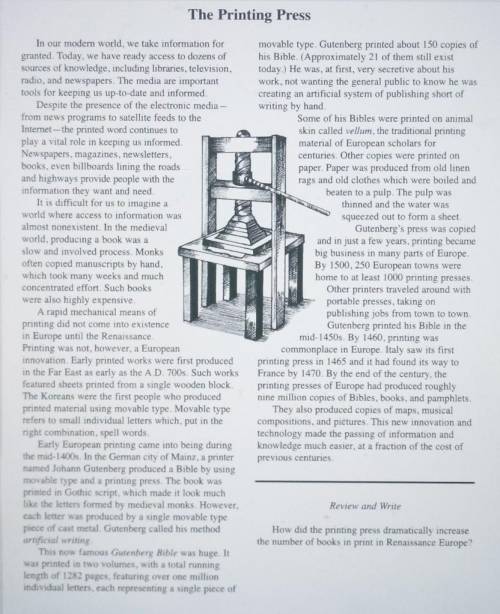
History, 27.03.2021 07:20 jewelzoe49
The Printing Press In our modern world, we take information for granted. Today, we have ready access to dozens of sources of knowledge, including libraries, television radio, and newspapers. The media are important tools for keeping us up-to-date and informed Despite the presence of the electronic media - from news programs to satellite feeds to the Internet - the printed word continues to play a vital role in keeping us informed. Newspapers, magazines, newsletters, books, even billboards lining the roads and highways provide people with the information they want and need It is difficult for us to imagine a world where access to information was almost nonexistent. In the medieval world, producing a book was a slow and involved process. Monks often copied manuscripts by hand, which took many weeks and much concentrated effort Such books were also highly expensive. A rapid mechanical means of printing did not come into existence in Europe until the Renaissance Printing was not, however, a European innovation Early printed works were first produced in the Far East as early as the AD 700s. Such works featured sheets printed from a single wooden block The Koreans were the first people who produced printed material using movable type. Movable type refers to small individual letters which, put in the right combination, spell words Early European printing came into being during the mid-1400s. In the German city of Mainz, a printer named Johann Gutenberg produced a Bible by using movable type and a printing press. The book was printed in Gothic script, which made it look much like the letters formed by medieval monks. However, each letter was produced by a single movable type piece of cast metal Gutenberg called his method artificial writing This now famous Gutenberg Bible was huge It was printed in two volumes, with a total running length of 1282 pages, featuring over one million individual letters, each representing a single piece of movable type Gutenberg printed about 150 copies of his Bible (Approximately 21 of them still exist today.) He was, at first, very secretive about his work, not wanting the general public know he was creating an artificial system of publishing short of writing by hand Some of his Bibles were printed on animal skin called vellum, the traditional printing material of European scholars for centuries. Other copies were printed on paper Paper was produced from old linen rags and old clothes which were boiled and beaten to a pulp. The pulp was thinned and the water was squeezed out to form a sheet Gutenberg's press was copied and in just a few years, printing became big business in many parts of Europe By 1500, 250 European towns were home to at least 1000 printing presses. Other printers traveled around with portable presses, taking on publishing jobs from town to town Gutenberg printed his Bible in the mid-1450s. By 1460. printing was commonplace in Europe Italy saw its first printing press in 1465 and it had found its way to France by 1470. By the end of the century, the printing presses of Europe had produced roughly nine million copies of Bibles, books, and pamphlets They also produced copies of maps, musical compositions, and pictures. This new innovation and technology made the passing of information and knowledge much easier, at a fraction of the cost of previous centuries
Review and Write How did the printing press dramatically increase the number of books in print in Renaissance Europe?
look at picture for better view PLZ ANSWERRR FASTTT
JUST ONE PARAGRAPH PLZ


Answers: 1
Another question on History

History, 21.06.2019 18:00
The congress shall have power to lay and collect taxes, duties, imposts and excises, to pay the debts and provide for the common defence and general welfare of the united states . .; to borrow money on the credit of the united states; to regulate commerce with foreign nations, and among the several states, and with the indian tribes. —constitution of the united states, article i, section 8 which of these are expressed powers granted by this part of article i, section 8? check all that apply. lay and collect taxes and duties pay debts regulate american indian groups regulate commerce within states borrow money regulate commerce with foreign nations
Answers: 3

History, 21.06.2019 20:10
Which of the following is true about elizabeth i's reign? she enforced the catholic church as england's official religion. she began a series of holy wars to fight puritans. the church of england was established by law. puritans supported the her commitment to any religion,
Answers: 1

History, 22.06.2019 09:00
Brainliestttme : ) -why is “extremist” a better term for describing the ideology of a terrorist?
Answers: 1

History, 22.06.2019 09:10
Classify the most significant contributions of the two major indian empires to world culture
Answers: 1
You know the right answer?
The Printing Press In our modern world, we take information for granted. Today, we have ready access...
Questions

Mathematics, 12.10.2019 15:10

History, 12.10.2019 15:10

Computers and Technology, 12.10.2019 15:10

Mathematics, 12.10.2019 15:10


Biology, 12.10.2019 15:10



Computers and Technology, 12.10.2019 15:10

Mathematics, 12.10.2019 15:10

Mathematics, 12.10.2019 15:10

Mathematics, 12.10.2019 15:10

Mathematics, 12.10.2019 15:10

Mathematics, 12.10.2019 15:10





History, 12.10.2019 15:10



